
Leads4Pass 1z0-071 dumps contain 388 latest exam questions and answers, which is currently the most suitable exam study material for candidates! Because Leads4Pass is the most cost-effective and provides flexible learning solutions in both PDF and VCE formats!
And each update will share an online exercise, the most important thing is to share for free! So candidates can freely choose to practice for free to improve their strength, or directly download the latest updated Leads4Pass 1z0-071 dumps: https://www.leads4pass.com/1z0-071.html help you 100% succeed.
Using PDF or VCE:
Leads4Pass 1z0-071 dumps include PDF and VCE learning formats, you can choose any according to your learning habits!
1z0-071 dumps PDF: Contains the latest exam questions and answers, the file is portable for all systems and browsers
1z0-071 dumps VCE: Provides online practice tests, timing, and explanations of difficult problems, and most of the questions are illustrated with text to ensure that you can learn easily
Leads4Pass is an open and inclusive website, we will distribute some free 1z0-071 exam questions and answers from time to time for your online exam practice test:
| From | Number of exam questions | Exam name | Last updated | Latest update |
| Leads4Pass | 15 | Oracle Database 12c SQL | 1z0-071 dumps | 2024 |
Question 1:
Which three statements are true about views in an Oracle database?
A. A SELECT statement cannot contain a where clause when querying a view containing a WHERE clause in its defining query
B. Rows inserted into a table using a view are retained in the table if the view is dropped
C. Views can join tables only if they belong to the same schema.
D. Views have no segment.
E. Views have no object number.
F. A view can be created that refers to a non-existent table in its defining query.
Correct Answer: BDF
Question 2:
Examine the description of the EMPLOYEES table:

Which statement will execute successfully, returning distinct employees with non-null first names?
A. SELECT DISTINCT * FROM employees WHERE first_ name IS NOT NULL;
B. SELECT first_ name, DISTINCT last_ name FROM employees WHERE first_ name IS NOT NULL;
C. SELECT Distinct * FROM employees WHERE first_ name < > NULL;
D. SELECT first_ name, DISTINCT last_ name FROM employees WHERE first_ name < > NULL;
Correct Answer: A
Question 3:
Examine the description of the transactions table:

Which two SQL statements execute successfully?
A. SELECT customer_id AS “CUSTOMER-ID”, transaction_date AS DATE, amount+100 “DUES” from transactions;
B. SELECT customer_id AS \’CUSTOMER-ID\’,transaction_date AS DATE, amount+100 \’DUES\’ from transactions;
C. SELECT customer_id CUSTID, transaction_date TRANS_DATEamount+100 DUES FROM transactions;
D. SELECT customer_id AS “CUSTOMER-ID”, transaction_date AS “DATE”, amount+100 DUES FROM transactions;
E. SELECT customer id AS CUSTOMER-ID, transaction_date AS TRANS_DATE, amount+100 “DUES AMOUNT” FROM transactions;
Correct Answer: CD
Question 4:
Examine the data in the NEW_EMPLOYEES table:

Examine the data in the EMPLOYEES table: You want to:

1.
Update existing employee details in the EMPLOYEES table with data from the NEW EMPLOYEES table.
2.
Add new employee detail from the NEW_ EMPLOYEES able to the EMPLOYEES table.
Which statement will do this:
A. MERGE INTO employees e USING new employees ne WHERE e.employee_id = ne. employee_ id WHEN MATCHED THEN UPDATE SET e.name = ne. name, e.job_id = ne.job_id,e.salary =ne. salary WHEN NOT MATCHED THEN INSERT VALUES (ne. employee_id,ne.name, ne.job_id,ne.salary) ;
B. MERGE INTO employees e USING new_employees n ON (e.employee_id = ne.employee_id) WHEN MATCHED THEN UPDATE SET e.name = ne. name, e.job id = ne.job_id,e.salary =ne. salary WHEN NOT MATCHED THEN INSERT VALUES (ne. employee_id,ne.name,ne.job_id,ne.salary);
C. MERGE INTO employees e USING new employees ne ON (e.employee_id = ne.employee_id) WHEN FOUND THEN UPDATE SET e.name =ne. name, e.job_id=ne.job_id, e.salary =ne.salary WHEN NOT FOUND THEN INSERT VALUES (ne.employee_id,ne.name,ne.job_id,ne.salary) ;
D. MERGE INTO employees e USING new_employees n WHERE e.employee_id = ne.employee_id WHEN FOUND THEN UPDATE SET e.name=ne.name,e.job_id =ne.job_id, e.salary=ne.salary WHEN NOT FOUND THEN INSERT VALUES (ne. employee_ id,ne. name,ne. job id,ne. salary) ;
Correct Answer: B
Question 5:
You execute the following commands:
SQL > DEFINE hire date = \’01-APR-2011\’
SQL >SELECT employee_id, first_name, salary
FROM employees
WHERE hire_date > \’andhiredate\’
AND manager_id > andmgr_id;
For Which substitution variables are you prompted for the input?
A. none, because no input is required
B. both the substitution variables \’\’hiredate\’ and \’mgr_id\’.
C. only hiredate\’
D. only \’mgr_id\’
Correct Answer: D
Question 6:
Examine the structure of the EMPLOYEES table.
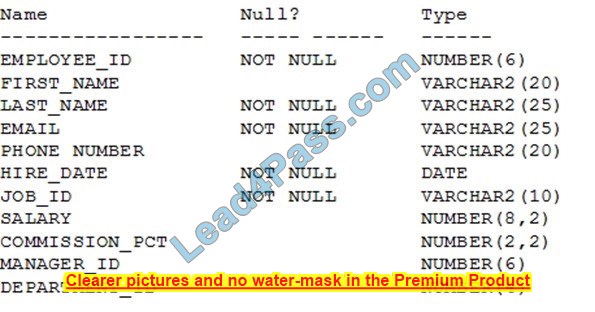
There is a parent/child relationship between EMPLOYEE_ID and MANAGER_ID.
You want to display the last names and manager IDs of employees who work for the same manager as the employee whose EMPLOYEE_ID is 123.
Which query provides the correct output?
A. SELECT e.last_name, m.manager_id FROM employees e RIGHT OUTER JOIN employees m on (e.manager_id = m.employee_id) AND e.employee_id = 123;
B. SELECT e.last_name, m.manager_id FROM employees e LEFT OUTER JOIN employees m on (e.employee_id = m.manager_id) WHERE e.employee_id = 123;
C. SELECT e.last_name, e.manager_id FROM employees e RIGHT OUTER JOIN employees m on (e.employee_id = m.employee_id) WHERE e.employee_id = 123;
D. SELECT m.last_name, e.manager_id FROM employees e LEFT OUTER JOIN employees m on (e.manager_id = m.manager_id) WHERE e.employee_id = 123;
Correct Answer: D
Question 7:
Examine the description of the EMPLOYEES table:

Which two queries return rows for employees whose manager works in a different department?
A. SELECT emp. * FROM employees emp WHERE manager_ id NOT IN ( SELECT mgr.employee_ id FROM employees mgr WHERE emp. department_ id < > mgr.department_ id );
B. SELECT emp.* FROM employees emp WHERE NOT EXISTS ( SELECT NULL FROM employees mgr WHERE emp. manager id = mgr. employee_ id AND emp.department_id<>mgr.department_id );
C. SELECT emp.* FROM employees emp LEFT JOIN employees mgr ON emp. manager_ id = mgr. employee_ id AND emp. department id < > mgr. department_ id;
D. SELECT emp. * FROM employees emp RIGHT JOIN employees mgr ON emp. manager_ id = mgr. employee id AND emp. department id <> mgr.department_ id WHERE emp. employee_ id IS NOT NULL;
E. SELECT emp. * FROM employees emp JOIN employees mgr ON emp. manager_ id = mgr. employee_ id AND emp. department_ id<> mgr.department_ id;
Correct Answer: DE
Question 8:
Which three statements are true about Structured Query Language (SQL)?
A. It guarantees atomicity, consistency, isolation, and durability (ACID) features
B. It best supports relational databases
C. It is used to define encapsulation and polymorphism for a relational table
D. It requires that data be contained in hierarchical data storage
E. It is the only language that can be used for both relational and object-oriented databases
F. It provides independence for logical data structures being manipulated from the underlying physical data storage
Correct Answer: ABF
Question 9:
Examine this SQL statement: SELECT cust_id, cus_last_name “Last Name” FROM customers WHERE country_id = 10 UNION SELECT cust_id CUST_NO, cust_last_name FROM customers WHERE country_id = 30 Identify three ORDER BY clauses, any one of Which can complete the query successfully.
A. ORDER BY 2, 1
B. ORDER BY “CUST_NO”
C. ORDER BY 2,cust_id
D. ORDER BY CUST_NO
E. ORDER BY “Last Name”
Correct Answer: ACE
Question 10:
Examine the description of the EMPLOYEES table:
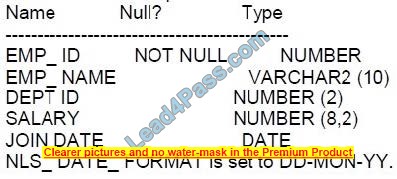
Which query requires explicit data type conversion?
A. SELECT SUBSTR(join date, 1, 2) – 10 FROM employees;
B. SELECT join_ date + \’20\’ EROM employees;
C. SELECT join_ date`\’ salary FROM employees;
D. SELECT join _ date FROM employees WHERE join date > *10-02-2018\’;
E. SELECT salary + \’120.50\’ FROM employees;
Correct Answer: D
Question 11:
Examine the description of the CUSTOMERS table:
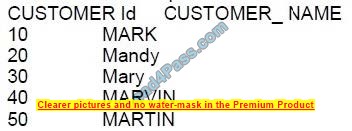
Which two SELECT statements will return these results:
CUSTOMER_ NAME
Mandy
Mary
A. SELECT customer_ name FROM customers WHERE customer_ name LIKE \’ % a % \’ ;
B. SELECT customer_ name FROM customers WHERE customer name LIKE \’Ma%\’ ;
C. SELECT customer_ name FROM customers WHERE customer_ name=\’*Ma*\’;
D. SELECT customer_ name FROM customers WHERE UPPER (customer_ name ) LIKE \’MA*. ;
E. SELECT customer_ name FROM customers WHERE customer name LIKE \’Ma*\’;
F. SELECT customer_ name FROM customers WHERE UPPER (customer name) LIKE \’ MAand\’;
G. SELECT customer_ name FROM customers WHERE customer_ name KIKE .*Ma*\’;
Correct Answer: AB
Question 12:
View the exhibit and examine the description of the PRODUCT_INFORMATION table.
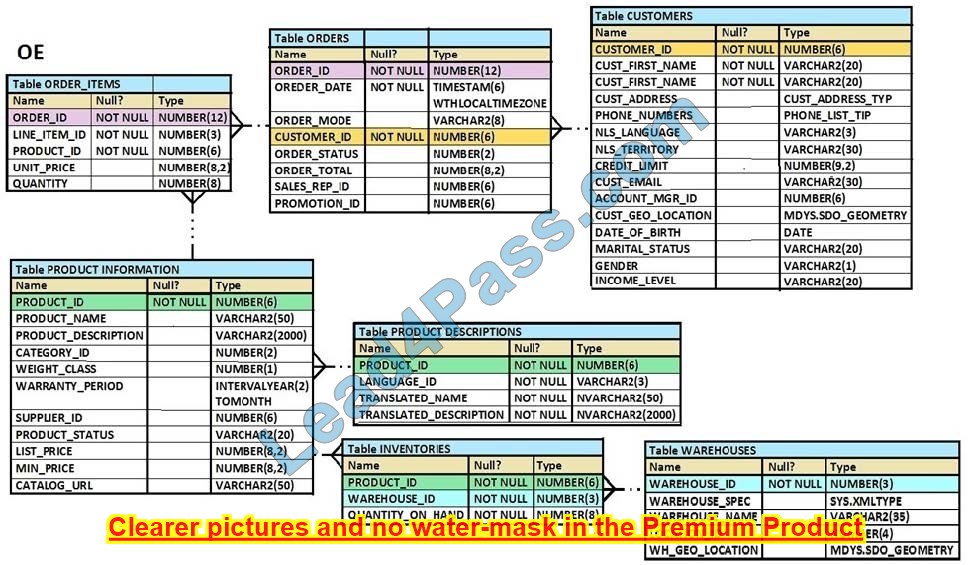
Which SQL statement would retrieve from the table the number of products having LIST_PRICE as NULL?
A. SELECT COUNT (DISTINCT list_price) FROM product_information WHERE list_price is NULL
B. SELECT COUNT (NVL(list_price, 0)) FROM product_information WHERE list_price is NULL
C. SELECT COUNT (list_price) FROM product_information WHERE list_price i= NULL
D. SELECT COUNT (list_price) FROM product_information WHERE list_price is NULL
Correct Answer: B
Question 13:
Which two are true about the USING clause when joining tables?
A. All column names in a USING clause must be qualified with a table name or table alias.
B. It can never be used with a natural join.
C. It is used to specify an equijoin of columns that have the same name in both tables.
D. It can never be used with a full outer join.
E. It is used to specify an explicit join condition involving operators.
Correct Answer: BE
Question 14:
Examine This Statement Which returns the name of each employee and their manager,
SELECT e.last name AS emp, m.last_name AS mgr
FROM employees e JOIN managers m
ON e.manager_ id = m. employee_ id ORDER BY emp;
You want to extend the query to include employees with no manager. What must you add before JOIN to do this?
A. CROSS
B. FULL OUTER
C. LEFT OUTER
D. RIGHT OUTER
Correct Answer: C
Question 15:
Examine this command:
TRUNCATE TABLE test;
Table truncated.
Which two are true? (Choose two.)
A. The structure of the TEST table is removed.
B. All the indexes on the TEST table are dropped.
C. All the constraints on the TEST table are dropped.
D. Removed rows can not be recovered using the ROLLBACK command.
E. All the rows in the TEST table are removed.
Correct Answer: AC
Share the latest 2024 Oracle 1z0-071 dumps exam questions and answers
| From | Number of exam questions | Time |
| Leads4Pass | 15/388 | March 2024 |
Which three tasks can be performed using SQL functions built into Oracle Database?
A. displaying a date in a nondefault format
B. finding the number of characters in an expression
C. substituting a character string in a text expression with a specified string
D. combining more than two columns or expressions into a single column in the output
Correct Answer: ABC
In Oracle Database, SQL functions provide a wide range of capabilities for manipulating and transforming data. Among the tasks you can perform using built-in SQL functions in Oracle Database, the correct answers are:
A. Displaying a date in a nondefault format: Oracle provides the TO_DATE and TO_CHAR functions for working with date values. The TO_CHAR function, in particular, can convert a date to a string in various formats, allowing dates to be displayed in non-default formats according to the needs of the application or user preferences.
B. Finding the number of characters in an expression: The LENGTH function is used in Oracle to find the number of characters in a string expression. This function can be very useful for validation, formatting, or processing decisions based on the length of character strings.
C. Substituting a character string in a text expression with a specified string: The REPLACE function allows you to substitute all occurrences of a specified character string within a text expression with another string. This can be used for data cleaning, formatting, or manipulation tasks where certain text patterns need to be replaced with different text.
While option D (combining more than two columns or expressions into a single column in the output) is a common task in SQL, it is typically achieved using the concatenation operator || rather than a specific built-in function. However, it’s important to note that functions like CONCAT can also be used for combining two values, but for more than two, you would generally use the concatenation operator directly in your SQL statements.
Thus, the correct answers as provided, A, B, and C, are tasks that can indeed be performed using SQL functions built into Oracle Database, highlighting the versatility and power of Oracle’s SQL function library for data manipulation and formatting.
Which two statements are true about Oracle databases and SQL?
A. Updates performed by a database user can be rolled back by another user by using the ROLLBACK command.
B. The database guarantees read consistency at the select level on user-created tables.
C. When you execute an UPDATE statement, the database instance locks each updated row.
D. A query can access only tables within the same schema.
E. A user can be the owner of multiple schemas In the same database.
Correct Answer: BC
In Oracle databases and SQL, the true statements among the options given are:
B. The database guarantees read consistency at select levels on user-created tables.
Oracle Database ensures read consistency, meaning that a query sees a consistent snapshot of the data as it existed at the point in time when the query began. This applies to all user-created tables. Oracle uses mechanisms such as undo data to provide this level of consistency, ensuring that readers do not block writers and vice versa. This feature is crucial for maintaining data accuracy and integrity during concurrent data access.
C. When you execute an UPDATE statement, the database instance locks each updated row.
Oracle employs row-level locking automatically when an UPDATE statement is executed. This means that when a row is being updated, it is locked to prevent other transactions from modifying it until the transaction is either committed or rolled back. This locking mechanism helps in maintaining data integrity and prevents update conflicts.
Now, let’s briefly address why the other statements are not true:
A. Updates performed by a database user can be rolled back by another user by using the ROLLBACK command.
This statement is not true. A ROLLBACK command can only affect the transaction of the session that issues it. One user cannot roll back the transactions of another user. Transactions are isolated among users/sessions, adhering to the ACID properties of database systems.
D. A query can access only tables within the same schema.
This statement is not accurate. A query can access tables in other schemas if the user executing the query has been granted the necessary permissions. Oracle allows cross-schema access through proper security and permission settings.
E. A user can be the owner of multiple schemas in the same database.
This statement is incorrect. In Oracle, a schema is essentially the same thing as a user. A schema is tied to a database user, and a user owns a single schema. However, a user can have objects in other schemas and can access objects in other schemas if permissions are granted.
Therefore, the correct answers are B and C, reflecting key aspects of Oracle’s database management and data integrity mechanisms.
Evaluate these commands Which execute successfully CREATE SEQUENCE ord_seq
INCREMENT BY 1
START WITH 1
MAX VALUE 100000
CYCLE
CACHE 5000;
Create table ord_items(
ord_no number(4) default ord_seq.nextval not null,
Item_no number(3),
Qty number(3),
Expiry_date date,
Constraint it_pk primary key(ord_no,item_no),
Constraint ord_fk foreign key (ord_no) references orders(ord_no));
Which two statements are true about the ORD_ITEMS table and the ORD_SEQ sequence?
A. Any user inserting rows into table ORD_ITEMS must have been granted access to sequence ORD_SEQ.
B. Column ORD_NO gets the next number from sequence ORD_SEQ whenever a row is inserted into ORD_ITEMS and no explicit value is given for ORD_NO.
C. Sequence ORD_SEQ cycles back to 1 after every 5000 numbers and can cycle 20 times
D. IF sequence ORD_SEQ is dropped then the default value for column ORD_NO will be NULL for rows inserted into ORD_ITEMS.
E. Sequence ORD_SEQ is guaranteed not to generate duplicate numbers.
Correct Answer: AB
You execute the following commands:
SQL > DEFINE hiredate = \’01-APR-2011\’
SQL >SELECT employee_id, first_name, salary
FROM employees
WHERE hire_date > \’andhiredate\’
AND manager_id > andmgr_id;
For Which substitution variables are you prompted for the input?
A. none, because no input is required
B. both the substitution variables \’\’hiredate\’ and \’mgr_id\’.
C. only hiredate\’
D. only \’mgr_id\’
Correct Answer: D
In the given SQL command sequence, there’s an attempt to use substitution variables with the DEFINE command and within the SELECT query. However, the way these variables are referenced in the query impacts whether you’ll be prompted for input.
The command:
DEFINE hiredate = ’01-APR-2011′
This sets a substitution variable hiredate to a specific date. In Oracle SQL*Plus or SQLcl, the DEFINE command is used to create or modify a substitution variable.
The query:
SELECT employee_id, first_name, salary
FROM employees
WHERE hire_date > ‘andhiredate’
AND manager_id > andmgr_id;
In this query, the intention seems to be to use the previously defined hiredate substitution variable and another variable mgr_id that hasn’t been defined within the provided commands.
The correct way to reference a substitution variable in SQLPlus or SQLcl is to precede it with an ampersand (&) for single substitution or double ampersands (&&) for defining a variable that retains its value after first substitution. However, the way hiredate is referenced ('andhiredate') is incorrect because of the quotes and the prefix ‘and’ instead of ‘&’. Due to this incorrect referencing, SQLPlus or SQLcl will not recognize it as a substitution variable within the context of this command. Thus, it will not prompt for its value; instead, it would treat 'andhiredate' as a literal string.
For the mgr_id variable, it is correctly referenced as andmgr_id; (assuming a typo in the question – it should be &mgr_id;), so SQL*Plus or SQLcl would prompt for its value because it’s correctly prefixed with an ampersand and hasn’t been defined prior to its use.
Therefore, the correct answer is:
D. only ‘mgr_id’
You will be prompted to input a value for the mgr_id substitution variable, because it’s the only one correctly, indicated as a substitution variable that hasn’t been defined prior.
Examine the description of the EMPLOYEES table:

Which two queries return rows for employees whose manager works in a different department?
A. SELECT emp. * FROM employees emp WHERE manager_ id NOT IN ( SELECT mgr.employee_ id FROM employees mgr WHERE emp. department_ id < > mgr.department_ id );
B. SELECT emp.* FROM employees emp WHERE NOT EXISTS ( SELECT NULL FROM employees mgr WHERE emp. manager id = mgr. employee_ id AND emp.department_id<>mgr.department_id );
C. SELECT emp.* FROM employees emp LEFT JOIN employees mgr ON emp. manager_ id = mgr. employee_ id AND emp. department id < > mgr. department_ id;
D. SELECT emp. * FROM employees emp RIGHT JOIN employees mgr ON emp. manager_ id = mgr. employee id AND emp. department id <> mgr.department_ id WHERE emp. employee_ id IS NOT NULL;
E. SELECT emp. * FROM employees emp JOIN employees mgr ON emp. manager_ id = mgr. employee_ id AND
Correct Answer: DE
Examine the data in the PRODUCTS table:

Examine these queries:
1.
SELECT prod name, prod list FROM products WHERE prod 1ist NOT IN(1020) AND category _id=1;
2.
SELECT prod name, | prod _ list FROM products WHERE prod list < > ANY (1020) AND category _id= 1; SELECT prod name, prod _ list FROM products WHERE prod_ list <> ALL (10 20) AND category _ id= 1; Which queries generate the same output?
A. 1 and 3
B. 1, 2 and 3
C. 2 and 3
D. 1 and 2
Correct Answer: A
Examine the description of the PROMOTIONS TABLE:

You want to display the unique promotion costs in each promotion category. Which two queries can be used?
A. SELECT DISTINCT promo_category, promo_cost FROM promotions ORDER BY 1;
B. SELECT promo_cost, promo_category FROM promotions ORDER BY 1
C. SELECT promo_category, DISTINCT promo_cost FROM promoting ORDER BY 2:
D. select DISTINCT promo_categoryIl `has\’||promol_cost as COSTS FROM promotions ORDER BY 1:
E. SELECT DISTINCT promo_cost ||\’in\’IIDISTINCT promo_category promotions ORDER BY1:
Correct Answer: AD
Examine the description of the EMPLOYEES table:

Which statement increases each employeeandapos;s SALARY by the minimum SALARY for their DEPARTM ENT_ID?
A. UPDATE employees e1 SET salary =(SELECT e2. salary + MIN(e2.salary) FROM employees e2 WHERE e1.department_ id = e2. department_id GROUP BY e2. department_id) ;
B. UPDATE employees e1 SET salary = salary + (SELECT MIN(e1. salary) FROM employees e2 WHERE e1.department_id = e2 .department_id);
C. UPDATE employees e1 SET salary = salary+(SELECT MIN (salary) FROM employees e2) ;
D. UPDATE employees e1 SET salary= (SELECT e1.salary + MIN(e2.salary) FROM employees e2 WHERE e1. department_ id = e2.department_id);
Correct Answer: D
The CUSTOMERS table has a CUST_LAST_NAME column of data type VARCHAR2.
The table has two rows whose CUST_LAST_NAME values are Anderson and Ausson.
Which query produces output for CUST_LAST_NAME containing Oder for the first row and Aus for the second?
A. SELECT REPLACE(REPLACE(cust_last_name, ‘son
Correct Answer: A
Which three statements are true about the DESCRIBE command?
A. It can be used by SQL Developer.
B. It can be used to display the structure of an existing view.
C. It can be used only from SQL*Plus.
D. It displays the NOT NULL constraint for any columns that have that constraint.
E. It displays all constraints that are defined for each column.
F. It displays the PRIMARY KEY constraint for any column or columns that have that constraint.
Correct Answer: ABD
The DESCRIBE command in Oracle Database is a useful tool for understanding the structure of database objects. Here are the true statements regarding the DESCRIBE command:
A. It can be used by SQL Developer.
- True. SQL Developer, a popular integrated development environment (IDE) for working with Oracle Database, allows users to execute the DESCRIBE command to view the structure of database objects, such as tables, views, and more.
B. It can be used to display the structure of an existing view.
- True. The DESCRIBE command can be used to display the structure of a view, including information about the columns that constitute the view.
C. It can be used only from SQL*Plus.
- False. While the DESCRIBE command is commonly associated with SQL*Plus, Oracle’s command-line interface, it can also be used in other environments, such as SQL Developer, SQLcl, and other tools that interface with Oracle Database.
D. It displays the NOT NULL constraint for any columns that have that constraint.
- True. When you use the DESCRIBE command on a table, it will indicate which columns have the NOT NULL constraint applied to them.
E. It displays all constraints that are defined for each column.
- False. The DESCRIBE command provides a concise overview of the structure of a table or view, including column names, data types, and whether a column is nullable. However, it does not display all types of constraints (like CHECK, UNIQUE, FOREIGN KEY) that are defined for each column. For comprehensive constraint information, data dictionary views such as USER_CONSTRAINTS and USER_CONS_COLUMNS would need to be queried.
F. It displays the PRIMARY KEY constraint for any column or columns that have that constraint.
- False. Similar to statement E, the DESCRIBE command does not explicitly show if a column is part of a PRIMARY KEY constraint. Information about primary keys can be obtained by querying the appropriate data dictionary views.
Given these clarifications, the correct answers are A, B, and D.
You must create a SALES table with these column specifications and data types: (Choose the best answer.)
SALESID: Number STOREID: Number ITEMID: Number QTY: Number, should be set to 1 when no value is specified SLSDATE: Date, should be set to the current date when no value is specified PAYMENT: Characters up to 30 characters, should be set to CASH when no value is specified
Which statement would create the table?
A. CREATE TABLE sales( salesid NUMBER(4), storeid NUMBER(4), itemid NUMBER(4), qty NUMBER DEFAULT = 1, slsdate DATE DEFAULT SYSDATE, payment VARCHAR2(30) DEFAULT = “CASH”);
B. CREATE TABLE sales( salesid NUMBER(4), storeid NUMBER(4), itemid NUMBER(4), qty NUMBER DEFAULT 1, slsdate DATE DEFAULT \’SYSDATE\’, payment VARCHAR2(30) DEFAULT CASH);
C. CREATE TABLE sales( salesid NUMBER(4), storeid NUMBER(4), itemid NUMBER(4), qty NUMBER DEFAULT = 1, slsdate DATE DEFAULT SYSDATE, payment VARCHAR2(30) DEFAULT = “CASH”);
D. CREATE TABLE sales( salesid NUMBER(4), storeid NUMBER(4), itemid NUMBER(4), qty NUMBER DEFAULT 1, slsdate DATE DEFAULT SYSDATE, payment VARCHAR2(30) DEFAULT \’CASH\’);
Correct Answer: D
The correct statement to create the SALES table with the specified column specifications and data types, along with default values, is:
D. CREATE TABLE sales( salesid NUMBER(4), storeid NUMBER(4), itemid NUMBER(4), qty NUMBER DEFAULT 1, slsdate DATE DEFAULT SYSDATE, payment VARCHAR2(30) DEFAULT ‘CASH’);
This statement correctly uses the DEFAULT keyword to specify default values for columns without the need for an equals sign (=), uses SYSDATE for the current date without quotes, and correctly encloses the string default value ‘CASH’ in single quotes, as per SQL syntax requirements.
View the exhibit and examine the structure of ORDERS and CUSTOMERS tables.
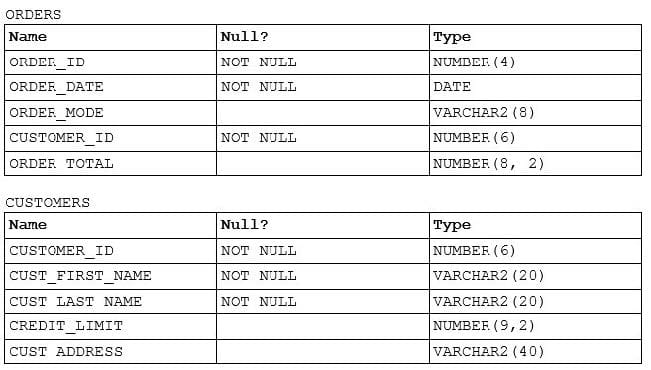
Which INSERT statement should be used to add a row into the ORDERS table for the customer whose CUST_LAST_NAME is Roberts and CREDIT_LIMIT is 600? Assume there exists only one row with CUST_LAST_NAME as Roberts and CREDIT_LIMIT as 600.
A. INSERT INTO (SELECT o.order_id, o.order_date, o.order_mode, c.customer_id, o.order_total FROM orders o, customers c WHERE o.customer_id = c.customer_id AND c.cust_last_name=\’Roberts\’ AND c.credit_limit=600) VALUES (1,\’10-mar-2007\’, \’direct\’, (SELECT customer_id FROM customers WHERE cust_last_name=\’Roberts\’ AND credit_limit=600), 1000);
B. INSERT INTO orders (order_id, order_date, order_mode, (SELECT customer_id FROM customers WHERE cust_last_name=\’Roberts\’ AND credit_limit=600), order_total) VALUES (1,\’10-mar-2007\’, \’direct\’, andcustomer_id, 1000);
C. INSERT INTO orders VALUES (1,\’10-mar-2007\’, \’direct\’, (SELECT customer_id FROM customers WHERE cust_last_name=\’Roberts\’ AND credit_limit=600), 1000);
D. INSERT INTO orders (order_id, order_date, order_mode, (SELECT customer_id FROM customers WHERE cust_last_name=\’Roberts\’ AND credit_limit=600), order_total) VALUES (1,\’10-mar-2007\’, \’direct\’, andandcustomer_id, 1000);
Correct Answer: C
Which two statements are true regarding the GROUP BY clause in a SQL statement? (Choose two.)
A. You can use column alias in the GROUP BY clause.
B. Using the WHERE clause after the GROUP BY clause excludes the rows after creating groups.
C. The GROUP BY clause is mandatory if you are using an aggregate function in the SELECT clause.
D. Using the WHERE clause before the GROUP BY clause excludes the rows before creating groups.
E. If the SELECT clause has an aggregate function, then those individual columns without an aggregate function in the SELECT clause should be included in the GROUP BY cause.
Correct Answer: DE
In SQL, the GROUP BY clause is used to arrange identical data into groups with the help of aggregate functions like SUM(), AVG(), MAX(), MIN(), and COUNT(). Let’s address the true statements among the provided options:
A. You can use column alias in the GROUP BY clause.
- False. Most SQL databases do not allow the use of column aliases in the
GROUP BYclause because theGROUP BYoperation occurs before the selection of columns (and thus before aliases are applied). Aliases are typically allowed in theORDER BYclause.
B. Using the WHERE clause after the GROUP BY clause excludes the rows after creating groups.
- This statement seems to be misleadingly formulated. The
WHEREclause is actually used before the groups are created, to filter rows entering into the aggregation process. TheHAVINGclause is used to filter groups after they have been created by theGROUP BYclause.
C. The GROUP BY clause is mandatory if you are using an aggregate function in the SELECT clause.
- False. You can use aggregate functions in the
SELECTclause without aGROUP BYclause if you are aggregating over the entire result set. TheGROUP BYclause is only mandatory if you want to aggregate data in grouped subsets of the entire result set.
D. Using the WHERE clause before the GROUP BY clause excludes the rows before creating groups.
- True. The
WHEREclause filters rows before they are grouped by theGROUP BYclause. This allows for the exclusion of certain rows from the groups based on specific criteria.
E. If the SELECT clause has an aggregate function, then those individual columns without an aggregate function in the SELECT clause should be included in the GROUP BY clause.
- True. This is a fundamental rule of SQL. When using aggregate functions in a
SELECTstatement that also selects individual columns, those individual columns must be included in theGROUP BYclause to define how the data should be grouped for the aggregation to apply.
Therefore, the correct answers are D and E, as they accurately describe how the GROUP BY clause functions in a SQL statement.
Which two actions can you perform with object privileges?
A. Create roles.
B. Delete rows from tables in any schema except sys.
C. Set default and temporary tablespaces for a user.
D. Create FOREIGN KEY constraints that reference tables in other schemas.
E. Execute a procedure or function in another schema.
Correct Answer: DE
Object privileges in Oracle and other SQL databases refer to the rights to perform specific actions on database objects (such as tables, views, procedures, etc.) owned by another user. These privileges must be granted explicitly to a user or a role by the owner of the object or a user with the GRANT OPTION privilege for that object. Among the given options, the two actions that can be performed with object privileges are:
D. Create FOREIGN KEY constraints that reference tables in other schemas.
- This action requires the REFERENCES object privilege on the table in the other schema that you want to reference with a FOREIGN KEY constraint. This privilege allows a user to define a foreign key that references the primary key or a unique key of the table owned by another user.
E. Execute a procedure or function in another schema.
- This action requires the EXECUTE object privilege on the specific procedure or function. With this privilege, a user can execute a stored procedure or function that is owned by another user.
Let’s clarify why the other options are not correct in the context of object privileges:
A. Create roles.
- Creating roles is not an object privilege but a system privilege. Roles are database objects that group together other privileges (both system and object privileges) that can be granted to users or other roles.
B. Delete rows from tables in any schema except sys.
- Deleting rows from a table requires the DELETE object privilege on that specific table. However, the privilege is specific to each table and does not inherently allow deletion from tables in any schema except SYS by default.
C. Set default and temporary tablespaces for a user.
- Setting default and temporary tablespaces for a user is an action related to user account management, not an object privilege. It requires ALTER USER system privilege or equivalent administrative rights.
Therefore, the correct answers are D and E, as they are actions that can be directly associated with object privileges in a database.
Reference: http://www.cruzroja.es/help/wvtdbobp.htm
Examine the description of the COUNTRIES table:

Examine the description of the DEPARTMENTS table:

Examine the description of the LOCATIONS table:

Which two queries will return a list of countries with no departments? (Choose two.)
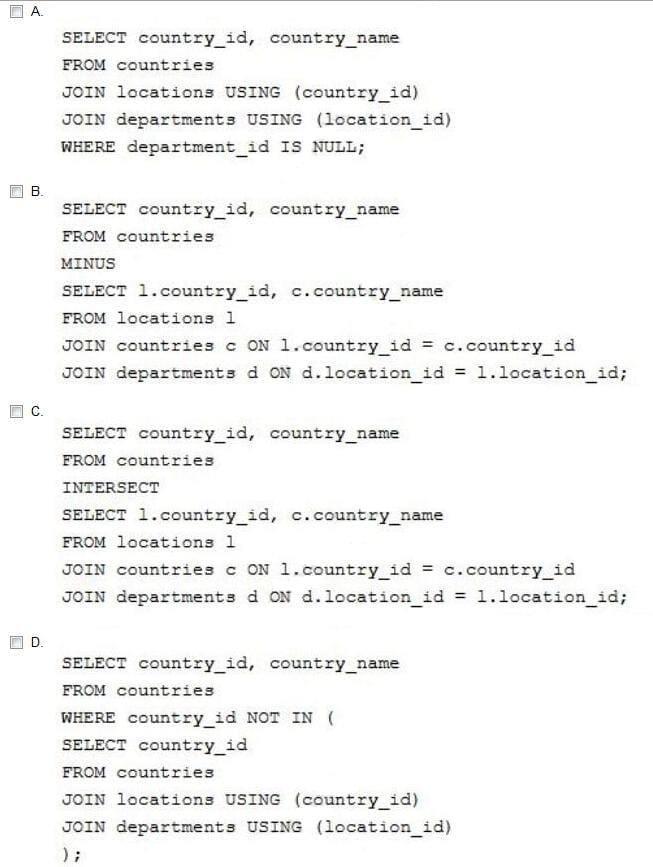
A. Option A
B. Option B
C. Option C
D. Option D
Correct Answer: BD
…
PS. Further practice complete 1z0-071 exam questions: https://www.leads4pass.com/1z0-071.html (388 Q&A Updated 2024)
Oracle 1z0-071 Certification Exam Worth
You should understand that the gold content of Oracle Database certification is very high.
The Oracle 1z0-071 certification exam is a very popular exam, which is very suitable for all candidates entering the Oracle field, especially for all talents who intend to enter the database field!
Summarize
Leads4Pass 1z0-071 dumps is a must-have material for anyone entering the field of “Oracle database”! You can follow us to get every online update or use 1z0-071 dumps: https://www.leads4pass.com/1z0-071.html
Helping you with all your study preparation plans! And anytime you use Leads4Pass 1z0-071 dumps you are guaranteed to be up to date!
Good luck!